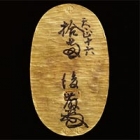本館 14室
2016年8月2日(火) ~ 2016年9月25日(日)
日本における金属貨幣の初期の例は、教科書にも登場する「富本銭(ふほんせん)」や、文様を表さない「無文銀銭(むもんぎんせん)」(飛鳥時代7世紀)です。その後250年の間に、日本では「和同開珎(わどうかいちん)」(奈良時代8世紀)など、「皇朝十二銭(こうちょうじゅうにせん)」とよばれる12種類の銅貨が発行されました。平安時代10世紀末には貨幣の製造は停止され、鎌倉時代や室町時代には、もっぱら中国製の銅貨(渡来銭)が流通しました。
室町時代16世紀、いわゆる戦国時代を迎えると、各地の大名の領内で、商取引や戦功へのほうびに使用するための金銀貨が作られるようになります。その代表ともいえるのが、武田信玄(1521~73)が製造させた「甲州金(こうしゅうきん)」で、これは江戸時代の貨幣制度のもとともなりました。やがて天下統一を果たした豊臣秀吉(1537~98)が、最初の大判金である「天正大判(てんしょうおおばん)」を作らせます。江戸時代になると徳川幕府が貨幣制度を統一するとともに、渡来銭の使用を禁じ、ここに日本独自の貨幣制度が確立しました。
本特集では、日本の古代から近世までの貨幣の歴史をたどります。教科書や時代劇で目にしたことのある貨幣の実物をご覧ください。

